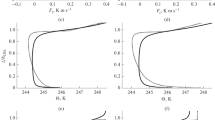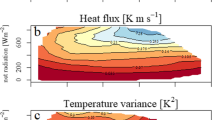Abstract
A major factor that influences the diurnal variation of turbulent kinetic energy (TKE) is the sensible heat flux at the surface. Here, the TKE variations are analysed during the morning transition phase because subsequent to the neutral or stable stratification during the night, peaks of concentration of scalars develop. The characteristics of the TKE during the growth phase of convection are analysed with the help of two analytical models. For this purpose, a three-dimensional spectral model of the growth of convection, starting from a neutral layer, and other formulations of micrometeorological parameters such as the convective and neutral spectra, velocity variance and dissipation rates are utilised. The peak values in the TKE spectra in the lower, middle and upper levels of the convective boundary layer showed a migration to higher wavelengths as the convection increased with time. The TKE evolutions generated by the analytical models agree fairly well with the results of large-eddy simulation for three vertical levels.
Similar content being viewed by others
References
Angevine W, Baltink H, Bosveld F (2001) Observations of the morning transition of the convective boundary layer. Boundary-Layer Meteorol 101: 209–227
Ayotte K, Sullivan P, Andrén A, Doney S, Hostlag A, Large W, McWilliams J, Moeng C-H, Otte M, Tribbia J, Wyngaard J (1996) An evaluation of neutral and convective planetary boundary-layer parameterizations relative to large eddy simulations. Boundary-Layer Meteorol 79: 131–175
Bange J, Spiess T, van den Kroonenberg A (2007) Characteristics of the early-morning shallow convective boundary layer from Helipod flights during STINHO-2. Theor Appl Climatol 90: 113–126
Banta R (1985) Late-morning jump in TKE in the mixed layer over a mountain basin. J Atmos Sci 42: 407–411
Batchvarova E, Gryning S-E (1990) Applied model for the growth of the daytime mixed layer. Boundary-Layer Meteorol 56: 261–274
Campos Velho H (2003) A preliminary model for growing of the convective boundary layer. Ciência e Natura, (special issue: proceedings of the Brazilian workshop on micrometeorology, 26–28 November, 2003, Santa Maria (RS), Brazil), pp 99–102
Caughey S, Palmer S (1979) Some aspects of turbulence structure through the depth of the convective boundary layer. Q J Roy Meteorol Soc 105: 811–827
Chandrasekar A, Philbrick C, Clarck R, Doddridge B, Georgopoulos P (2003) A large-eddy simulation study of the convective layer over Philadelphia during the 1999 summer NE-OPS campaign. Environ Fluid Mech 3: 305–329
Chemel C, Chollet J (2006) Observations of the daytime boundary layer in deep Alpine Valleys. Boundary-Layer Meteorol 119: 239–262
Deardorff J (1970) Convective velocity and temperature scales for the unstable planetary boundary layer and for Rayleigh convection. J Atmos Sci 27: 1211–1213
Deardorff J (1979) Prediction of convective mixed-layer entrainment for realistic capping inversion structure. J Atmos Sci 36: 424–436
Deardorff J (1980) Stratocumulus-capped mixed layers derived from three-dimensional model. Boundary-Layer Meteorol 18: 495–527
Degrazia G, Campos Velho H, Carvalho J (1997) Nonlocal exchange coefficients for the convective boundary layer derived from spectral properties. Beitr Phys Atmos 70: 57–64
Degrazia G, Goulart A, Anfossi D, Campos Velho H, Lukaszcyk P, Palandi J (2003) A model base on Heisenberg’s theory for the eddy diffusivity in decaying turbulence applied to the residual layer. Nuovo Cimento 26: 39–51
Degrazia G, Nunes A, Satyamurty P, Acevedo O, Campos Velho H, Rizza U, Carvalho J (2007) Employing Heisenberg’s turbulent spectral transfer theory to parameterize sub-filter scales in LES models. Atmos Environ 41: 7059–7068
Driedonks A. (1982) Models and observations of the growth of the atmospheric boundary layer. Boundary-Layer Meteorol 23: 283–306
Garc J, Cancillo M, Cano J (2002) A case study of the morning evolution of the convective boundary layer depth. J Appl Meteorol 41: 1053–1059
Goulart A, Degrazia G, Rizza U, Anfossi D (2003) A theoretical model for the study of convective turbulence decay and comparison with large-eddy simulation data. Boundary-Layer Meteorol 107: 143–155
Grant A (1997) An observational study of the evening transition boundary-layer. Q J Roy Meteorol Soc 123: 657–677
Grimsdell A, Angevine W (2002) Observations of the afternoon transition of the convective boundary layer. J Appl Meteorol 41: 3–11
Helmis C, Asimakopoulos D, Deligiorgi D (1990) Some observations on the destruction of the morning temperature inversions in a large and broad mountain valley. J Appl Meteorol 29: 396–400
Hinze J (1975) Turbulence. McGraw-Hill, New York, p 790
Højstrup J (1982) Velocity spectra in the unstable planetary boundary layer. J Atmos Sci 39: 2239–2248
Kaimal J, Wyngaard J, Izumi Y, Coté O (1972) Spectral characteristics of surface layer turbulence. Q J Roy Meteorol Soc 98: 563–589
Kaimal J, Wyngaard J, Haugen D, Coté O, Izumi Y, Caughey S, Readings C (1976) Turbulence structure m the convective boundary layer. J Atmos Sci 33: 2152–2169
Kristensen L, Lenschow D, Kirkegaard P, Courtney M (1989) The spectral velocity tensor for homogeneous boundary-layer turbulence. Boundary-Layer Meteorol 47: 149–193
Lapworth A (2006) The morning transition of nocturnal boundary layer. Boundary-Layer Meteorol 119: 501–526
Lenschow D, Stankov B, Mahrt L (1979) The rapid morning boundary-layer transition. J Atmos Sci 36: 2108–2124
Ma J, Daggupaty S (2000) Using all observed information in a variational approach to measuring z0m and z0t . J Appl Meteorol 39: 1391–1410
Mangia C, Degrazia G, Rizza U (2000) An integral formulation for the dispersion parameters in a shear-buoyancy-driven planetary boundary layer for use in a gaussian model for tall stacks. J Appl Meteorol 39: 1913–1922
Moeng C-H (1984) A Large-Eddy Simulation model for the study of planetary boundary-layer turbulence. J Atmos Sci 41: 2052–2062
Moeng C-H, Wyngaard J (1988) Spectral analysis of large-eddy simulations of the convective boundary layer. J Atmos Sci 45: 3573–3587
Nieuwstadt F, Mason P, Moeng C-H, Schumann U (1992) Large-Eddy Simulation of the convective boundary layer: A comparison of four computer codes. In: Durst F (eds) Turbulent shear flows 8. Springer, Berlin, pp 343–367
Panofsky H, Tennekes H, Lenschow D, Wyngaard JC (1977) The characteristics of turbulent velocity components in the surface layer under convective conditions. Boundary-Layer Meteorol 11: 355–361
Riordan A, Davis J, Kiess R (1986) The morning inversion near the ground and its daytime transition at two rural sites in the Carolinas. J Clim Appl Meteorol 25: 239–256
Sorbjan Z (1997) Decay of convective turbulence revisited. Boundary-Layer Meteorol 82: 501–515
Sorbjan Z (2007) A numerical study of daily transitions in the convective boundary layer. Boundary-Layer Meteorol 123: 365–383
Stanišić M (1988) The mathematical theory of turbulence. Springer, Verlag, p 501
Sullivan P, McWilliams J, Moeng C-H (1994) A subgrid model for large-eddy simulation of planetary boundary layer flows. Boundary-Layer Meteorol 71: 247–276
Tennekes H (1973) A model for the dynamics of the inversion above a convective boundary layer. J Atmos Sci 30: 558–581
Triantafyllou A, Helmis C, Asimakopoulos D, Soilemes A (1995) Boundary layer evolution over a large and broad mountain. Theor Appl Climatol 52: 19–25
Yaglom A (1977) Comments on wind and temperature flux–profile relationships. Boundary-Layer Meteorol 11: 89–102
Author information
Authors and Affiliations
Corresponding author
Rights and permissions
About this article
Cite this article
Nunes, A.B., Campos Velho, H.F., Satyamurty, P. et al. Morning Boundary-Layer Turbulent Kinetic Energy by Theoretical Models. Boundary-Layer Meteorol 134, 23–39 (2010). https://doi.org/10.1007/s10546-009-9432-0
Received:
Accepted:
Published:
Issue Date:
DOI: https://doi.org/10.1007/s10546-009-9432-0




